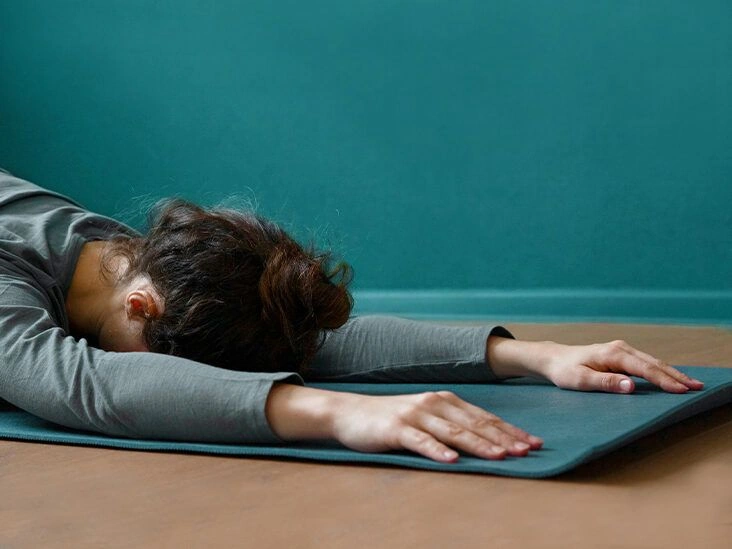Both dynamic and static stretching along with strengthening moves can alleviate discomfort in the upper back. Working on your core may also provide benefit.
Ouch — is neck and back discomfort getting in your way?
No matter what’s causing your pain — from leaning over a phone, sitting at a desk for long hours, or an injury — targeted stretches and strength exercises can significantly speed recovery.
Below are 19 exercises designed to stretch and reinforce muscles in your:
- neck
- shoulders
- upper back
- mid back
- lower back
For best outcomes, try to add these stretches and exercises into your routine several times per week.
Sample routine for upper back pain relief
How to warm up
First: loosen the muscles in the affected area with a dynamic warm-up that includes mobility drills.
Before exercising, prepare your muscles, ligaments, and joints for movement. Incorporating dynamic stretches helps raise tissue temperature and readiness. Start with 5–10 minutes of light cardio such as walking, biking, or an easy jog.
Static stretches — holding a position for a period — can increase flexibility and improve range of motion, but they’re generally better after your workout or as part of a more active warm-up beforehand.
This is because extended static holds (especially around 60 seconds or longer) can temporarily reduce muscular strength and endurance, slow reaction time, and impair performance.
If you want static stretches in your warm-up, keep holds to 10–20 seconds. Otherwise, save them for post-workout.
Dynamic stretches for the neck, shoulders, and upper back
Pick a few of the following movements and perform each for 30 seconds to 1 minute before exercising.
Neck roll
Good for: neck and upper back

- Stand or sit upright facing forward. Begin by tilting your head toward the right until you feel a stretch from your neck into your trapezius.
- After a second or two, slowly roll your head counterclockwise.
- Pause briefly as you reach the left shoulder.
- Finish the circle by returning to the starting position.
- Repeat the motion rolling clockwise.
- Perform the sequence 2–3 times.
Shoulder roll
Good for: shoulders and upper back

- Stand with your arms relaxed at your sides.
- Roll your shoulders backward in a circular motion 5 times, then roll them forward 5 times.
- Repeat this set 2–3 times.
Arm circles
Good for: shoulders

- Stand with arms extended to the sides, parallel to the floor, palms facing down.
- Circle your arms forward slowly, starting with small circles and gradually increasing size. Do 20 repetitions.
- Reverse direction and perform another 20 circles.
Overhead arm reach
Good for: shoulders and upper back

- Sit on a chair facing forward with feet flat on the floor.
- Raise your right arm overhead and reach to the left, bending your torso until you feel a stretch in your right lat and shoulder.
- Return to neutral. Repeat 5 times, then switch to the left arm.
Chair rotation
Good for: upper, mid, and lower back

- Sit sideways in a chair with your right side against the chair back.
- Keep your legs still and rotate your torso to the right, reaching for the chair back with your hands.
- Hold the twist and use your arms to deepen the stretch as your muscles relax.
- Maintain for 10 seconds. Repeat 3 times per side.
Cat-Cow
Good for: mid and lower back

- Begin on hands and knees with a neutral neck.
- Palms under shoulders, knees beneath hips.
- Inhale, tuck the pelvis and round the mid-back, drawing the navel to the spine and letting the head drop.
- After 3–5 seconds, exhale and return to neutral.
- Lift your face toward the ceiling, allowing your back to arch and sink toward the floor. Hold 3–5 seconds.
- Repeat the flow 5 times.
Knee to chest
Good for: lower back

- Lie on your back. Bend your left knee and pull it into your chest, holding for 5 seconds, then release.
- Repeat with the right leg.
- Perform the sequence 3 times.
Thoracic extension
Good for: upper and mid back

- A foam roller or a chair works best for this movement.
- With a foam roller, rest it under your thoracic spine letting your head and hips drop on either side. Reach your arms overhead to intensify the extension.
- Using a chair, sit facing forward and allow your upper torso to drape over the chair back. Extend your arms overhead for a deeper opening.
- Hold for 5 seconds, then relax. Repeat 3 times.
Strengthening exercises
Building strength in the back, shoulders, and neck is key to reducing and avoiding pain. Choose several of the exercises below to target these areas.
Some movements use dumbbells or resistance bands; others rely on body weight. Aim to include both types if you can.
Row
Good for: upper back

Use a resistance band or a light-to-medium dumbbell for this.
- Anchor a resistance band to something stable and hold each handle with arms extended.
- Pull the handles back by bending your elbows, keeping them hugging your sides. You should feel the lats engage.
- With a dumbbell, brace your free hand on a wall and hinge at the hips to about 45 degrees, letting the weight hang.
- Keep the neck neutral and knees slightly soft, then pull the dumbbell up with a tucked elbow.
- Do 2–3 sets of 8–12 repetitions.
Face pull
Good for: shoulders and upper back

- Attach a resistance band to a stable anchor above eye level.
- Grasp the handles with an overhand grip.
- Pull the band toward your face, flaring the upper arms and squeezing the shoulder blades together. Pause, then return.
- Perform 3 sets of 12 reps.
Scapular squeeze
Good for: shoulders and upper back

- Stand with arms at your sides and squeeze your shoulder blades together. Hold for 5 seconds, then relax.
- Repeat 3–5 times.
Wall angel
Good for: neck, shoulders, and upper back

- Stand with your back flat against a wall. You may need to step your feet out a bit to press your back gently against the wall.
- Raise your arms into a “T” against the wall, then bend elbows to 90 degrees.
- Slide your arms up and down like making a “snow angel,” keeping them in contact with the wall throughout.
- When fingertips touch overhead, return to start.
- Complete 3 sets of 10 reps.
Reverse dumbbell fly
Good for: shoulders and upper back

- Hold two light dumbbells and hinge at the hips to about 45 degrees with arms hanging down.
- With a neutral neck and gaze down, lift your arms out to the sides and up.
- Squeeze the shoulder blades at the top of the movement.
- Perform 3 sets of 8–12 reps.
Lat pulldown
Good for: shoulders and upper back

- Sit or stand beneath a resistance band anchored overhead.
- Pull the band down until your upper arms are parallel to the floor.
- Pause while squeezing the lats, then return to start.
- Do 3 sets of 8–12 reps.
Superman
Good for: mid and lower back

- Lie face down with arms extended overhead.
- Keep your neck neutral and lift both arms and legs off the floor together, using your back and glutes to lift.
- Hold briefly at the top, then lower back down.
- Complete 3 sets of 10 repetitions.
Static stretches for after your workout
Include static stretching after finishing your session.
Pec stretch
Good for: chest and shoulders

- Stand in a doorway and place your forearms on the frame with elbows bent at 90 degrees.
- Allow your body weight to shift forward slightly until you feel a stretch across the chest and shoulders.
- Hold for 10 seconds, then release. Repeat 3 times.
Child’s Pose
Good for: shoulders; upper, mid, and lower back

- Begin on all fours.
- With big toes touching, widen your knees as far as comfortable and sit your hips back toward your heels.
- Sit upright briefly with arms extended overhead.
- On an exhale, hinge at the hips and fold your upper body between your legs.
- Rest your forehead on the floor, allow the shoulders to open, and let the hips sink back.
- Hold for at least 15 seconds.
Butterfly
Good for: shoulders and upper back

- Place palms on opposite shoulders and bring your elbows to touch in front of your chest.
- Hold for 10–20 seconds, then release.
- Repeat 3–5 times.
Upper trapezius stretch
Good for: upper back and neck

- While standing or sitting upright, place your right hand on the back of your head and tuck your left hand behind your back.
- Gently pull your head toward your right shoulder using the right hand.
- Hold for 10–15 seconds.
- Repeat on the opposite side.
Levator scapulae stretch
Good for: neck and upper back

- While standing or seated, rotate your head about 45 degrees to the left.
- Tilt your chin downward as if looking into a shirt pocket. Use your left hand to increase the stretch if needed.
- Hold for 10–15 seconds.
- Repeat on the other side.
Frequently asked questions
When will back pain go away?
If you have mild soreness or an acute strain, how long pain lasts depends on the cause and severity.
Typically, many people notice improvement within weeks to months as muscles strengthen and tissues heal.
However, recovery varies by individual. Working with a certified trainer for a tailored exercise plan can be helpful for some.
If you have intense neck or back pain, consult a healthcare provider before beginning new activities.
When should you start exercising after an injury?
Returning to exercise too early can aggravate an injury and prolong recovery. It’s important to let injuries calm down and gradually resume activity.
Avoid exercise until you see reductions in pain, stiffness, and swelling. A useful benchmark is being able to perform routine household tasks with little or no pain and having near-full range of motion.
What else can you do for neck and back pain?
While neck and back-specific moves are important, include a variety of strengthening exercises for balanced fitness.
In particular, a strong core is linked to reduced lower back pain because it helps stabilize the spine. The core includes:
- transversus abdominis
- rectus abdominis
- internal and external obliques
- erector spinae (back extensors)
- multifidus
Multiple studies have found core-strengthening programs lead to improvements in lower back pain.
You may also benefit from other home remedies or professional treatments such as heat, over-the-counter analgesics, massage, or acupuncture.
If you sit at a desk, optimize your workspace ergonomics to reduce strain on the neck and back.
The bottom line
Often, neck and back pain can be managed at home with consistent stretching and strengthening exercises.
That said, every recovery is different and some people need a longer break before resuming activities. Consulting a physical therapist can further support healing for many.
Read this article in Spanish.


















Leave a Reply
You must be logged in to post a comment.